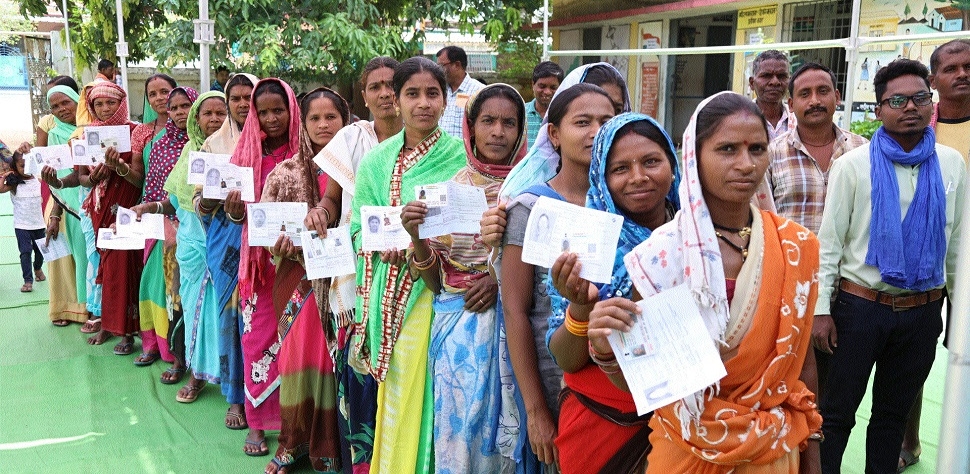Kanker polled highest 72.37% votes among 3 LS seats
| Date :19-Apr-2019 |

Staff Reporter RAIPUR:
Under the Second phase of Lok Sabha Elections – 2019 in Chhattisgarh, Kanker Lok Sabha constituency polled highest 72.37 percent votes followed by 71.76 percent in Rajnandgaon and 68.23 percent in Mahasamund as on 5 pm. The total average polling in these three Lok Sabha constituencies as on 5pm has been 71.09 percent, which is likely to increase as data from over 100 polling booths are still awaited. The polling percentage in Lok Sabha Elections – 2014 was 73.02 percent.
Addressing mediapersons on the outcome of polling in the second phase of Lok Sabha elections in Chhattisgarh, Subrat Sahoo, Chief Electoral Officer Chhattisgarh, said the polling on Thursday had been incident free and by and large peaceful barring one incident where one polling officer Sukalu Ram Nareti died of cardiac-arrest. He said as of now no zero polling has been reported from any booth. The CEO Chhattisgarh informed that in Kanker Lok Sabha constituency, highest polling percentage of 78 percent has been recorded from Gunderdehi Assembly segment followed by 76.99 in Sanjari-Balod, 74 percent in Sihawa, 73.48 percent in Daundi-Lohara, 73.02 percent in Kanker, 69.96 percent in Bhanupratappur, 68.15 percent in Keshkal and 62.3 percent in Antagarh Assembly segment. Similarly, in Mahasamund Lok Sabha, highest polling percentage of 73.35 percent has been recorded from Bindra Nawagarh Assembly segment followed by 73.2 percent in Rajim, 69.43 percent in Basna, 67.48 per cent in Saraipali, 67 percent in Kurud, 64 percent in Khallari and 62 percent in Dhamtari Assembly segment. In Rajnandgaon Lok Sabha, highest polling percentage of 76.7 percent has been recorded from Dongargarh Assembly segment followed by 76.1 percent in Dongargaon, 75.46 percent in Khujji, 74.67 percent in Mohla-Manpur, 74.25 percent in Khairagarh, 67 percent in Kawardha and 65 percent in Pandariya Assembly segment. Sahoo further informed that polling was held in 6,484 polling booths. He added that with the permission from ECI, 103 polling booths were shifted to new venues keeping in view the approachable conditions.
He said for the second phase of elections, four general observers, three expense observers and two police observers were deployed apart from 1390 micro-observers. Total 28,530 employees/officials were deployed in polling duty in the second phase, of which 59 polling parties were transported by helicopters. Altogether 5873 service voters were sent postal ballots online through ETPBS in these three Lok Sabha constituencies. Web-casting was carried out in 1240 polling booths in the second phase. CEO Sahoo while informing about the number of EVM’s which were replaced, said during Dispersal one Ballot Unit, zero Control Units and one VVPAT units were replaced. Similarly, during Mock Poll, 33 Ballot Units, 29 Control Units and 110 VVPAT units were replaced. During Actual Poll, six Ballot Units, six Control Units and 68 VVPAT units were replaced. The CEO Chhattisgarh informed that during the course of Lok Sabha elections in Chhattisgarh, a total of 346 complaints were received through c-VIGIL, of which, action was taken in 180 complaints after they were found correct and 166 complaints were found in-correct and were dropped.
Similarly, the Election Commission received a total of 2332 complaints, of which, action is in process in 27 complaints while 1850 complaints have been disposed off and 455 complaints are pending. CEO Sahoo informed that till date since the imposition of Model Code of Conduct, cash worth Rs 5,66,26,605, liquor to the tune of 6476.54 liters and other materials (freebies) worth Rs 77,62,969 were seized from various parts of the state. While informing about the highlights of polling during second phase, a 105 years old woman Dai Ramkunwar Bai exercised her franchise in village Podi in Kawardha district. Another 90 years old woman Son Kumari Nishad exercised her franchise in Rajnandgaon district. During the second phase of polling, 6732 Braille Ballot papers were used which facilitated voting for blind voters.